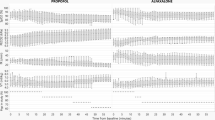Abstract
Anesthesia of the pig poses great problems for experimental animal-based research and particularly in shock research. In this study, five mechanically ventilated domestic pigs were given long-term anesthesia with a combination of ketamine plus pentobarbital. Circulatory parameters were recorded every 2 h via an arterial catheter placed in the right common carotid artery, a Swan-Gans thermodilution catheter (7F), that was placed in the pulmonary artery of the right middle-lobe in a wedge position through the external jugular vein, and another catheter in the internal jugular vein for measuring central venous pressure. Moreover, body weight, blood gases, pH, blood cells, electrolytes and serum enzymes were measured. Further serum traits as total protein and glucose and pathological alterations in different organs were recorded. The animals were observed for a period of 96 h and then killed painlessly. It was shown that pigs can survive 96-h anesthesia with the combination of ketamine and pentobarbital. Optimum, carefully controlled anesthesia did not impair the integrity of the regulatory mechanisms of circulation.
Similar content being viewed by others
References
Andersen OK, Lundgren T-I, Revhaug A, Österno B, Giercksky K-E (1984) Controlled endotoxemia in pigs. Acta Chir Scand 150: 599–606
Bickhard K (1980) Laborwerte beim Schwein. In: Schulze W, Bickhardt K, Bollwahn W, Mickwitz G von, Plonait H (ed) Klinik der Schweinekrankheiten, 1st edn. Schaper Hannover, pp 387–396
Chiu C-J, McArdle AH, Brown R, Scott HJ, Gurd FN (1970) Intestinal mucosal lesions in low-flow states. A morphological, hemodynamic and metabolic reappraisal. Arch Surg 101: 478–483
Dodds WJ (1982) The pig model for biomedical research. Fed Proc 41: 247–256
Douglas WR (1972) Of pigs and men and research: a review of applications and analogies of the pig, sus scrofa, in human medical research. Space Life Sci 3: 226–234
Framstad T, Ganter M, Sjostrand U, Stevens J, Thurmon J (1994) Ketamine and its use in the pig. Lab Anim 30: 209–219
Frimmer M (1986) Pharmakologie und Toxikologie, Lehrbuch für Veterinärmediziner und Naturwissenschaftler. Schattauer, Stuttgart, pp 229–231
Hannon JP (1985) Hemodynamic Characteristics of the conscious resting pig: a brief review. In: Tumbleson ME (ed) Swine in biomedical research, 1st edn. Plenum, New York, pp 1343–1345
Kerber RE, Pandian NG, Jensen SR, et al (1986) Effect of lidocaine and bretylium on energy requirements for transthoracic defibrillation: experimental studies. J Am Coll Cardiol 7: 397–405
Lava J, Rice CL, Levina HA, Moss GS (1982) Extravascular lung water as a function of the magnitude of pulmonary artery pressure in the septic pig. J Surg Res 32: 440–448
Lessler T, Ebner E, Zwiener U (1993) Ketamine-Diazepam N20 combination anesthesia —a new “circulatory-system-sparing” type of anesthetic in experimental surgery. Res Exp Med (Berl) 193: 207–211
Natale A, Douglas LJ, Kim Y-H, Klein GJ (1991) Effects of lidocaine on defibrillation threshold in pig: evidence of anesthesia related increase. Pacing Clin Electrophysiol 14: 1239–1244
Nilboer JA, Dorlas JC, Salt PJ (1986) The effect of ketamine on the peripheral circulation: a possible sympathetic ganglion blocking effect. Eur J Anaesth 3: 143–158
Priano LL, Traber DL, Wilson RD (1969) Barbiturate anestesia: an abnormal physiological situation. J Pharmacol Exp Ther 165: 126–135
Price HL (1960) General anestesia and circulatory homeostasis. Phys Rev 2: 187–218
Rendas AF, Branthwaite M, Reid L (1978) Growth of pulmonary circulation in normal pig —structural analysis and cardiopulmonary function. J Appl Physiol 45: 806–817
Strom J, Häggmark S, Reiz S, Bredgaard Sorensen M (1987) Cardiovascular effects of pentobarbital in pigs, and the lack of response to naloxone in pentobarbital induced circulatory failure. Acta Anaesthesiol Scand 31: 413–416
Tumbleson ME, Schmidt A (1985) Swine clinical chemistry. In: Tumbleson ME (ed) Swine in biomedical research, 1st edn. Plenum, New York, pp 783–807
Weiskopf B, Bogetz MS, Roizen MF, Reid IA (1984) Cardiovascular and metabolic sequelae of inducing anesthesia with ketamine or thiopental in hypovolemic swine. Anesthesiology 60: 214–219
Worek FS, Blümel G, Zeravik J, Zimmermann GJ, Pfeiffer UJ (1988) Comparison of ketamine and pentobarbital anesthesia with the conscious state in a porcine model of pseudomonas aeruginosa septicemia. Acta Anaesthesiol Scand 32: 509–515
Author information
Authors and Affiliations
Rights and permissions
About this article
Cite this article
Goldmann, C., Ghofrani, A., Hafemann, B. et al. Combination anesthesia with ketamine and pentobarbital: a long-term porcine model. Res. Exp. Med. 199, 35–50 (1999). https://doi.org/10.1007/s004330050131
Received:
Accepted:
Published:
Issue Date:
DOI: https://doi.org/10.1007/s004330050131




